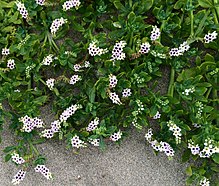|
Heliotropium curassavicum
Heliotropium curassavicum, commonly called salt heliotrope[2] (among other names), a species of flowering plant in the borage family (Boraginaceae). It is native to much of the Americas, from Canada to Argentina, including the West Indies and Hawaii. It can be found as an introduced, and sometimes invasive, species in Africa, Asia, Australia, and Europe.[3] It thrives in salty soils, such as beach sand, alkali flats, and salt marshes.[3] It is often found in disturbed coastal sites.[4] DescriptionThis is a perennial herb which can take the form of a prostrate creeper along the ground to a somewhat erect shrub approaching 0.5 m (1.6 ft) in height. The stem and foliage are fleshy, with the leaves thick and oval or spade-shaped. The plentiful inflorescences are curled, coiling double rows of small bell-shaped flowers. Each flower is white with five rounded lobes and a purple or yellow throat. The fruit is a smooth nutlet. NamesDue to its wide geographical range that spans many nations and languages, Heliotropium curassavicum has been given an assortment of common names. In English, these include seaside heliotrope, salt heliotrope, monkey tail, quail plant and Chinese parsley. In Latin American Spanish, it is known as cola de mico, cola de gama or rabo alacrán. It is called kīpūkai in Hawaii. TaxonomyThere are five currently recognized varieties.[3] These are:
References
External links
|
||||||||||||||||||||||||||||||||||
Portal di Ensiklopedia Dunia




